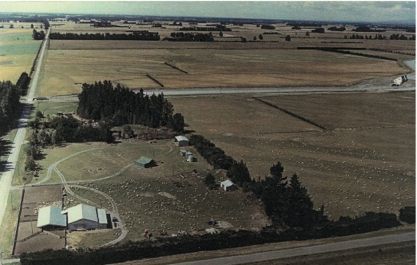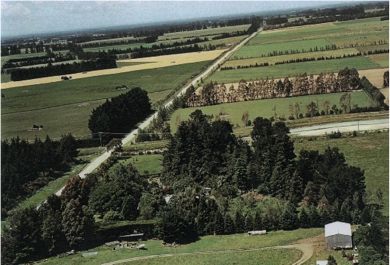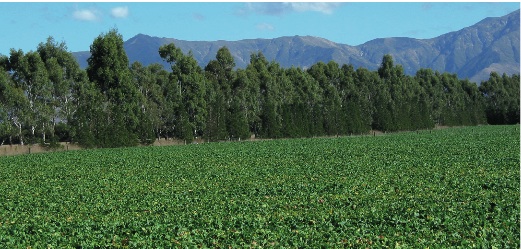Shining example of the farm forestry model: John and Betty Greenslade
Author not published, New Zealand Tree Grower August 2007.
Ashburton farmers John and Betty Greenslade are practising examples of what the farm forestry model is all about – trees wisely integrated into the New Zealand landscape for profit, amenity, conservation and sustainability. Deserving recipients of the 2007 South Island Farm Foresters of the Year Award, they have been farming their 345-hectare farm at Mayfield in central Canterbury since 1964.
Commitment to trees
In fact, the contrast between aerial photos taken back then and more recently neatly sums up their commitment to trees as a vital component of sustainable farming practice. John and Betty say their objective is to farm the property productively, profitably and in an environmentally sustainable manner, with animal health and welfare the main priority.
As those on last year’s Ashburton Conference field trip will recall, the Greenslades’ farm has its challenges. Light, very stony soils, nor’westerly gales, 900 mm of rainfall a year, no available irrigation, and at 360 metres above sea level, late winter snow falls. All these shape the Greenslade farm management strategies.
The farm is a high performing sheep, beef and deer property, carrying 4,000 stock units, mainly sheep. The home block is 228 hectares, predominantly Ruapuna stony silt loam, stocked with breeding ewes and deer. Another block of 117 hectares runs grazing steers and replacement ewe lambs. For the last three years the Greenslade have run Kelso composites, producing more meat per hectare than the previous Coopworths. The ewe flock is now lambing at 170%.


Shelterbelts
But back to the trees, which on Somerset Farm fulfil a number of purposes. Some 25 km of shelterbelts provide protection from wind and snow, and help keep the light topsoil from blowing out to sea.

Direct drilling, which John Greenslade helped pioneer in the district in 1982, also assists with soil retention.
While macrocarpas and pines have traditionally been the shelterbelt species of choice in the Canterbury region, John and Betty Greenslade have opted for two-row plantings, including the favoured combination of Spanish fir on the windward side and Pinus nigra on the lee, as well as others such as ponderosa pine to windward and eucalypts on the lee. Low growing native species are used for east-west intermediate shelter to help retain pasture moisture.
Different trees have been planted for different purposes. The ponderosas or gums filter the nor’wester but are not a solid wall, and help to retain the ground moisture. Others that are more solid protect from the south westerly. Shade is important too, with John and Betty clear that minimising stock stress is a prime objective of their operation. Their aim is to have some form of shelter or amenity planting over every fence line.
Extensive amenity plantings
Although a small radiata plantation does feature in the planting mix it is obvious the species is not their first love. With extensive gardens around both houses on the property, as well as an arboretum, the extensive amenity plantings make the landscape appear more like a park than a highly productive working farm. All told some 58 species of trees can be found at Somerset Farm, from oaks for shade and autumn colour, to cabbage trees and flax planted beside gateways and conifers around the deer fence. Every tree planted has its location and date of planting recorded.
In 2004 the Greenslades won the Supreme Canterbury Region Balance Environment Award, as well as the PPCS Best Livestock Farm Award and the Ballance Nutrient Management Award – tangible acknowledgement of the family’s commitment to sustainable farming. The judges described the Greenslades’ farm as ‘an outstanding example of sustainable agriculture’. Since then John has been involved on the judging side himself, which he says gives him the opportunity to visit different farms – and get more ideas for tree and shelterbelt plantings. On a property where sustainability is the watchword, it is nice to note that John is the third generation to farm Somerset, which was established by his grandfather. John’s son Mark now farms in partnership, passing the baton on to a fourth generation.

 Farm Forestry New Zealand
Farm Forestry New Zealand